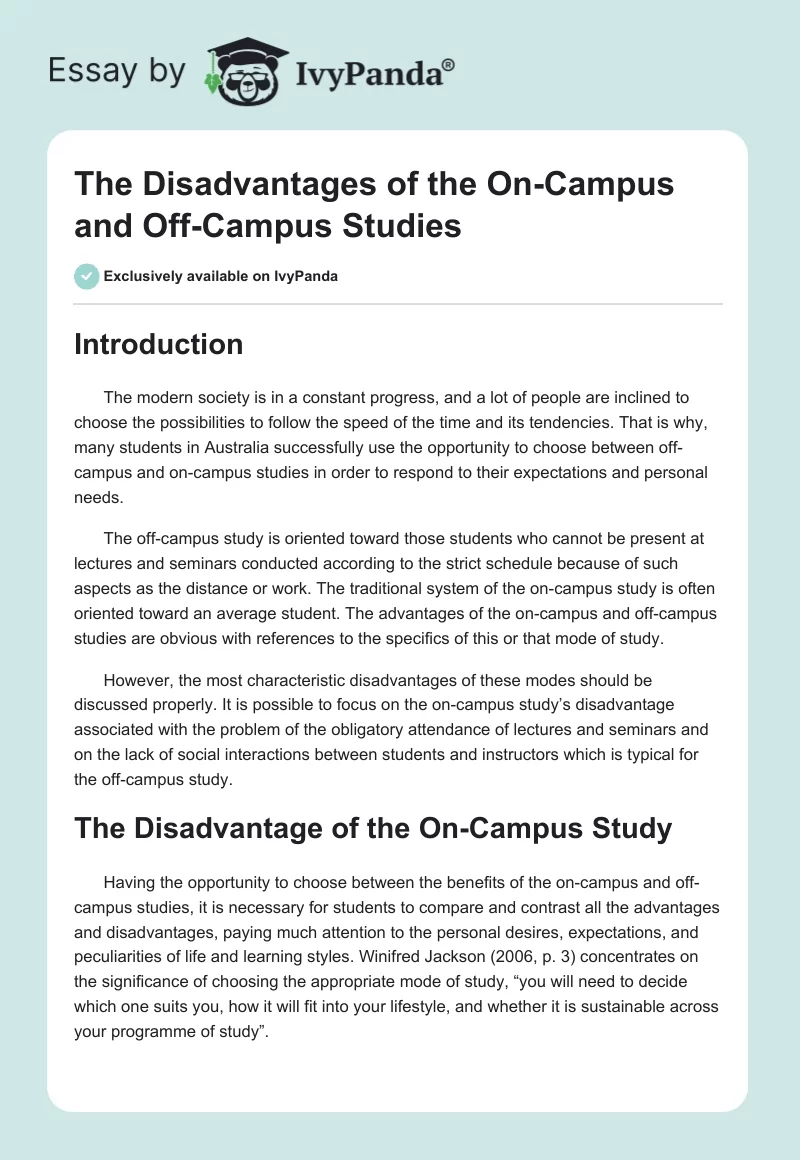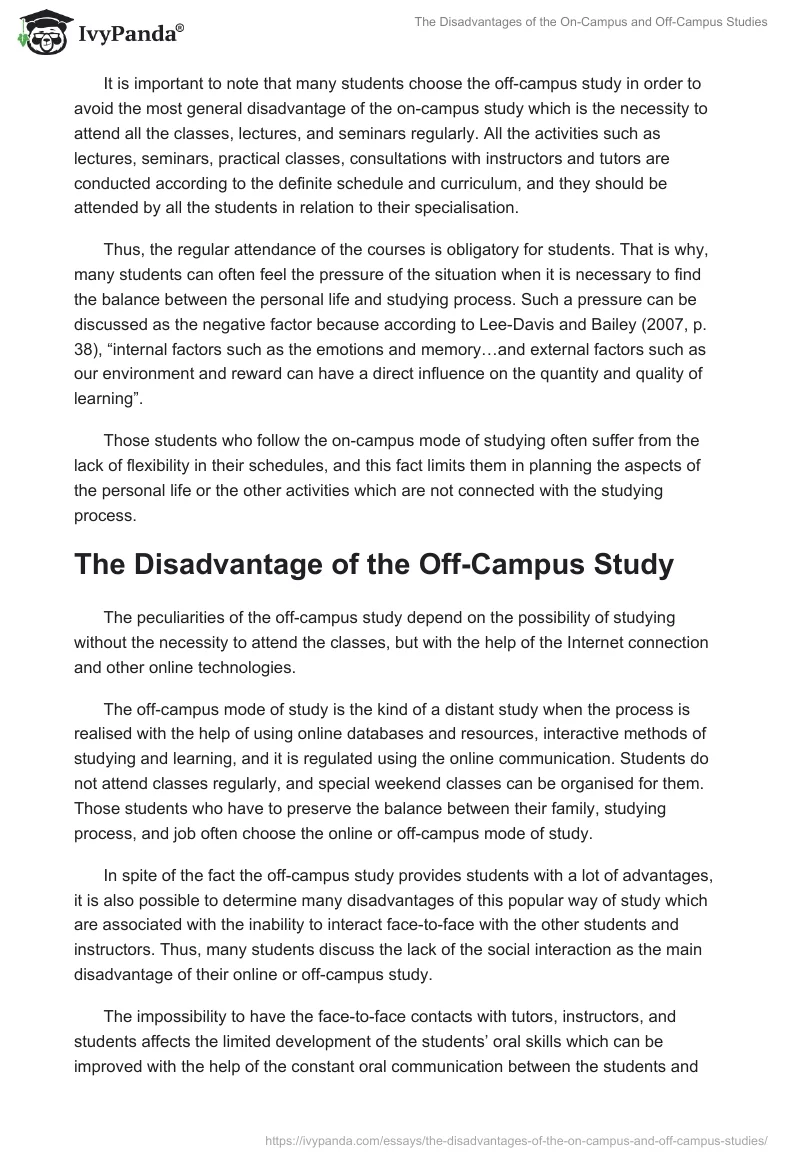Introduction
The modern society is in a constant progress, and a lot of people are inclined to choose the possibilities to follow the speed of the time and its tendencies. That is why, many students in Australia successfully use the opportunity to choose between off-campus and on-campus studies in order to respond to their expectations and personal needs.
The off-campus study is oriented toward those students who cannot be present at lectures and seminars conducted according to the strict schedule because of such aspects as the distance or work. The traditional system of the on-campus study is often oriented toward an average student. The advantages of the on-campus and off-campus studies are obvious with references to the specifics of this or that mode of study.
However, the most characteristic disadvantages of these modes should be discussed properly. It is possible to focus on the on-campus study’s disadvantage associated with the problem of the obligatory attendance of lectures and seminars and on the lack of social interactions between students and instructors which is typical for the off-campus study.
The Disadvantage of the On-Campus Study
Having the opportunity to choose between the benefits of the on-campus and off-campus studies, it is necessary for students to compare and contrast all the advantages and disadvantages, paying much attention to the personal desires, expectations, and peculiarities of life and learning styles. Winifred Jackson (2006, p. 3) concentrates on the significance of choosing the appropriate mode of study, “you will need to decide which one suits you, how it will fit into your lifestyle, and whether it is sustainable across your programme of study”.
It is important to note that many students choose the off-campus study in order to avoid the most general disadvantage of the on-campus study which is the necessity to attend all the classes, lectures, and seminars regularly. All the activities such as lectures, seminars, practical classes, consultations with instructors and tutors are conducted according to the definite schedule and curriculum, and they should be attended by all the students in relation to their specialisation.
Thus, the regular attendance of the courses is obligatory for students. That is why, many students can often feel the pressure of the situation when it is necessary to find the balance between the personal life and studying process. Such a pressure can be discussed as the negative factor because according to Lee-Davis and Bailey (2007, p. 38), “internal factors such as the emotions and memory…and external factors such as our environment and reward can have a direct influence on the quantity and quality of learning”.
Those students who follow the on-campus mode of studying often suffer from the lack of flexibility in their schedules, and this fact limits them in planning the aspects of the personal life or the other activities which are not connected with the studying process.
The Disadvantage of the Off-Campus Study
The peculiarities of the off-campus study depend on the possibility of studying without the necessity to attend the classes, but with the help of the Internet connection and other online technologies.
The off-campus mode of study is the kind of a distant study when the process is realised with the help of using online databases and resources, interactive methods of studying and learning, and it is regulated using the online communication. Students do not attend classes regularly, and special weekend classes can be organised for them. Those students who have to preserve the balance between their family, studying process, and job often choose the online or off-campus mode of study.
In spite of the fact the off-campus study provides students with a lot of advantages, it is also possible to determine many disadvantages of this popular way of study which are associated with the inability to interact face-to-face with the other students and instructors. Thus, many students discuss the lack of the social interaction as the main disadvantage of their online or off-campus study.
The impossibility to have the face-to-face contacts with tutors, instructors, and students affects the limited development of the students’ oral skills which can be improved with the help of the constant oral communication between the students and their tutors. Turner pays attention to the fact that the oral skills are developed basing on working out effective oral presentations and on using the definite oral techniques. The peculiarities of the off-campus study do not contribute to these skills’ improvement (Turner 2009).
Those students who study with the help of new technologies do not receive the immediate feedback as the important component of the effective studying process. Accentuating the significance of this aspect, Winifred Jackson (2006, p. 5) states that “an integral part of ongoing learning during your studies at any level is academic feedback”. The absence of the immediate feedback can provoke the students’ procrastination or decrease of the interest to the instructor’s commentaries.
Recommendations
To reduce the negative affects of the pressure caused by the strict schedule on the students who study according to the on-campus mode, it is necessary to work out the balanced everyday schedule according to which the stress of the students’ overload can be overcome.
Furthermore, some kinds of activities can be organised as optional in order to avoid the punishment for students’ not attending these classes. The accents on the definite flexibility should be associated with the efficient organisation of the schedules according to the peculiarities of curricula.
The lack of the social interactions as the typical feature of the off-campus study can be overcome with the help of using such technologies as Skype. Instructors and students can receive the opportunity to discuss the details of the studying process online, paying attention to the development of the oral skills.
Marshall and Rowland focus on the importance of students’ involving into the campus community and activities for developing their thinking skills and positive associations with the studying process (Marshall & Rowland 2006). That is why, the students studying distantly should have the opportunities to interact with the other students online for sharing their thoughts and opinions and to meet monthly or once a semester to develop the personal relationships.
Conclusion
The on-campus and off-campus modes of studying have a lot of advantages and disadvantages. Such disadvantages as the obligation to attend the classes according to the schedule for the students studying on-campus and the lack of the face-to-face interactions for the students studying off-campus can be reduced with the help of using the definite improvements of the studying process.
They can result in providing the definite flexibility of the schedule for the students following the on-campus mode. And the accents on using such original technologies as, for instance, Skype to provide the effective and immediate interactions between the tutors and students can be made.
Reference List
Jackson, W 2006, “Becoming a life-long learner”, in P Adams, R Openshaw, & V Trembath (eds), Score more: essential academic skills for tertiary education, Thomson Learning, Australia, pp. 2-7.
Lee-Davies, L & Bailey, S 2007, Developing work and study skills, Thomson Learning, Australia.
Marshall, LA & Rowland, F 2006, A guide to learning independently, Pearson Education, Frenchs Forest, N.S.W.
Turner, K 2009, Essential academic skills, Oxford University Press, Australia.


